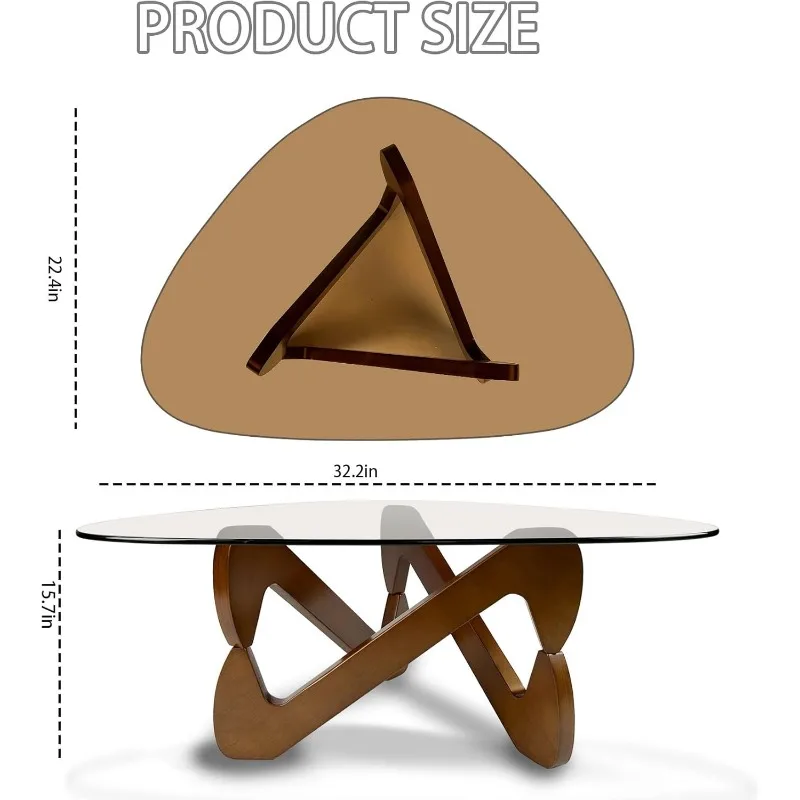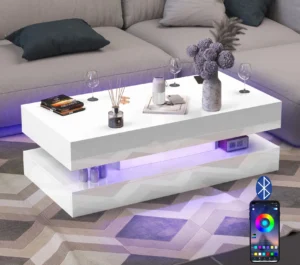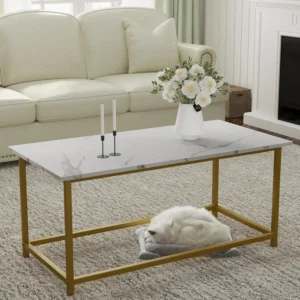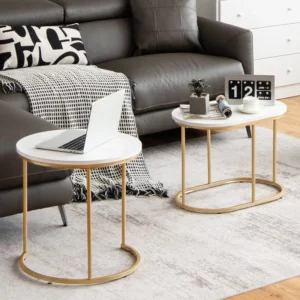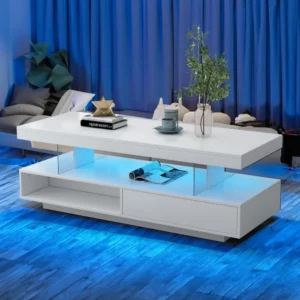Introduction: The Timeless Appeal of Glass Coffee Tables
Glass coffee tables have remained a beloved furniture staple for decades, offering a perfect blend of form and function that few other pieces can match. Their enduring popularity stems from an unmatched ability to create visual lightness in a room—a quality particularly valuable in smaller spaces where bulkier furniture might overwhelm. The transparent nature of glass creates an illusion of more space, allowing light to flow freely and making even modest living areas feel open and airy.
Beyond their space-enhancing properties, glass top coffee tables serve as versatile design chameleons that seamlessly integrate with virtually any interior style. Whether paired with sleek contemporary furnishings or traditional wooden pieces, a glass table adapts effortlessly to its surroundings. The durability of modern tempered glass also ensures these pieces stand up to daily use while maintaining their elegant appearance for years.
In this comprehensive guide, we’ll explore the diverse world of glass top coffee table ideas that continue to captivate interior designers and homeowners alike. From minimalist modern pieces to ornate traditional designs, we’ll examine how different styles, shapes, materials, and features can transform your living space. Whether you’re furnishing a new home or refreshing your current décor, understanding these design elements will help you select the perfect glass coffee table to enhance your interior aesthetic.
Modern & Minimalist Glass Coffee Table Designs
Modern and minimalist glass coffee tables epitomize clean sophistication through their uncluttered aesthetic and precise geometric forms. These designs prioritize function without sacrificing style, often featuring sleek lines and transparent surfaces that create a sense of visual lightness. The restraint in their design makes these tables particularly suitable for contemporary spaces where simplicity reigns supreme.
Key features of modern and minimalist glass coffee tables include:
- Streamlined silhouettes with precise angles or perfectly circular forms
- Thin frames in materials like chrome, brushed stainless steel, or matte black powder-coated metal
- Transparent or smoky glass tops with clean, straight edges
- Minimal ornamentation, letting the materials and proportions speak for themselves
- Occasional use of transparent acrylic bases for an almost invisible support structure
The beauty of these modern glass top coffee table design elements lies in their versatility. They create breathing space in busy rooms and provide a sophisticated anchor in more minimalist environments. When selecting a modern glass coffee table, consider how its proportions will complement your existing seating—lower tables create a casual atmosphere, while those level with seat cushions offer a more formal feel. The transparent nature of these designs means they work particularly well in smaller spaces, where more substantial pieces might overwhelm the room.
For those drawn to modern aesthetics, our collection of mid-century modern glass top coffee tables offers pieces that balance contemporary sleekness with timeless appeal, perfect for creating a sophisticated focal point in any living space.
Industrial Chic Glass Coffee Tables
Industrial chic glass coffee tables bring raw, workshop-inspired elements into refined living spaces, creating a compelling contrast between utilitarian materials and elegant glass surfaces. These designs celebrate the beauty of structural components rather than hiding them, turning what might typically be concealed into distinctive design features.
The industrial glass coffee table typically incorporates:
- Blackened or distressed steel frames with visible welds or rivets
- Exposed hardware elements like bolts, gears, or wheel mechanisms
- Combinations of metal with reclaimed or rough-hewn wood components
- Thicker glass tops (often 12mm or more) that balance the substantial base elements
- Architectural influences like truss structures or factory-inspired leg systems
What makes these designs particularly striking is how the glass top softens what would otherwise be heavy industrial elements. The transparency creates a visual lightness that counterbalances the robust materials below, allowing them to appear as though they’re floating in the room. This juxtaposition of industrial strength and delicate glass creates pieces that serve as compelling conversation starters.
Industrial glass coffee tables work especially well in loft spaces, open-concept living areas, and rooms with exposed brick, ductwork, or concrete elements. They also pair beautifully with leather furniture, creating a sophisticated yet approachable atmosphere that feels both curated and comfortable. For homes with predominantly soft furnishings, an industrial glass coffee table can introduce a welcome textural counterpoint that adds depth to the overall design scheme.
Mid-Century Modern Glass Coffee Table Interpretations
Mid-century modern glass coffee tables capture the essence of this beloved design era while incorporating contemporary elements for today’s living spaces. These pieces showcase the period’s signature balance of form and function, emphasizing clean lines, organic shapes, and the honest expression of materials that defined the movement from the 1940s through the 1960s.
The hallmarks of mid-century glass coffee tables include:
- Warm wood bases in teak, walnut, or oak with characteristic tapered legs
- Sculptural supports that create visual interest from every angle
- Biomorphic or geometric glass tops that complement the organic forms below
- Thoughtful proportions that prioritize both aesthetic appeal and practical function
- Integration of brass accents or smoked glass for added visual warmth

The enduring popularity of these designs stems from their remarkable versatility. Mid-century glass coffee tables work equally well in contemporary minimalist spaces, eclectic bohemian interiors, and more traditional settings. Their timeless quality comes from the thoughtful glass top mid-century coffee table layout tips that designers have refined over decades—placing the table at an ideal distance from seating, ensuring proper proportions, and creating a functional arrangement that encourages both conversation and comfort.
For those seeking authentic mid-century appeal, our mid-century modern walnut coffee tables showcase the rich warmth of this signature wood paired with elegant glass tops. These pieces celebrate the era’s commitment to craftsmanship while providing practical surfaces for modern living—truly embodying the philosophy that great design should be both beautiful and functional.
Luxurious & Glam Glass Coffee Table Styles
Luxurious and glam glass coffee tables make bold statements that elevate interiors with their opulent materials and eye-catching details. These sophisticated pieces serve as jewelry for the living room, incorporating precious metals, high-shine finishes, and dramatic proportions that command attention and exude elegance.
Distinguished features of luxury glass coffee tables include:
- Gold, brass, or polished nickel frames with immaculate finishes
- Beveled, mirrored, or etched glass surfaces that play with light and reflection
- Architectural influences from Art Deco and Hollywood Regency styles
- Intricate base designs featuring geometric patterns or flowing sculptural elements
- Premium construction details like hand-applied gold leaf or custom glass treatments
These sumptuous tables thrive in sophisticated interior schemes where they can be appreciated as focal pieces. Their reflective qualities help amplify light in a space, creating a sense of brightness and expansiveness that enhances the perceived size of a room. The interplay between metal and glass creates beautiful shadow patterns that shift throughout the day, adding another layer of visual interest.
When incorporating a luxurious glass coffee table into your space, consider pairing it with plush velvet upholstery, rich textiles, and strategic lighting that will highlight its reflective qualities. While these tables make bold statements, they can be balanced with more subdued surrounding elements to create a harmonious overall design that feels luxurious rather than overwhelming. These pieces work particularly well in formal living rooms, sophisticated apartments, and spaces where entertaining is a priority.
Traditional & Classic Glass Top Coffee Tables
Traditional and classic glass top coffee tables bridge the gap between time-honored furniture styles and contemporary functionality. These elegant pieces draw inspiration from historical design periods while incorporating glass elements that lighten their appearance and protect their often intricate woodwork or metalcraft.
Characteristic features of traditional glass coffee tables include:
- Richly finished wood frames in mahogany, cherry, or other classic hardwoods
- Ornate detailing like cabriole legs, carved moldings, or scrollwork
- Inset glass tops that protect and showcase decorative table frames
- Formal proportions with attention to symmetry and balanced design
- Occasional wrought iron or bronze metalwork with traditional motifs
What sets these tables apart is their ability to maintain a connection to historical furniture styles while offering practical benefits for modern living. The glass tops preserve elaborate wooden frameworks from spills and wear while allowing their craftsmanship to remain visible. This thoughtful combination creates pieces that honor traditional aesthetics while functioning beautifully in contemporary homes.
Traditional glass coffee tables excel in formal living rooms, studies, and spaces with classic architectural details. They pair naturally with tailored upholstery, antique accents, and rich textiles. While they might seem contradictory to contemporary sensibilities at first glance, these tables often surprise homeowners with their versatility—their elegant proportions and fine details can add a touch of sophistication to even the most modern interiors when thoughtfully incorporated.
Nature-Inspired & Organic Glass Coffee Table Designs
Nature-inspired glass coffee tables create compelling juxtapositions between organic, textural elements and sleek, manufactured glass. These designs bring the outdoors inside through materials and forms that echo natural environments, creating conversation pieces that connect interior spaces to the natural world.
Distinctive elements of nature-inspired glass coffee tables include:
- Live-edge wood, driftwood, or root bases that showcase natural grain patterns and organic shapes
- River stone, slate, or other natural stone components that provide textural contrast
- Rattan, bamboo, or other sustainable materials incorporated into base designs
- Glass tops that appear to float above natural elements, highlighting their beauty
- Preservation of natural imperfections that tell a story and create one-of-a-kind pieces
The appeal of these designs lies in how the transparent glass tops put natural elements on display, almost like museum pieces, while simultaneously serving practical functions. The glass preserves delicate natural materials while creating usable surfaces for daily life—a perfect marriage of form and function. These tables often become focal points that draw the eye and invite conversation about their origins and materials.
For those drawn to organic shapes, our mid-century modern round coffee tables often incorporate natural inspirations with their flowing lines and curved edges. These pieces work particularly well in spaces that embrace biophilic design principles, connecting interior environments to nature through materials, forms, and textures that evoke natural landscapes and elements.
Artistic & Sculptural Statement Pieces
Artistic and sculptural glass coffee tables transcend pure function to become legitimate works of art that transform living spaces. These bold designs blur the boundaries between furniture and sculpture, often created by designers who approach furniture as a medium for creative expression rather than merely utilitarian objects.
Distinguishing characteristics of artistic glass coffee tables include:
- Unconventional forms that challenge traditional furniture silhouettes
- Experimental combinations of materials that create visual tension
- Asymmetrical components that create dynamic visual movement
- Custom glass treatments like coloration, texturing, or artistic etching
- Limited-edition or one-of-a-kind production that emphasizes exclusivity
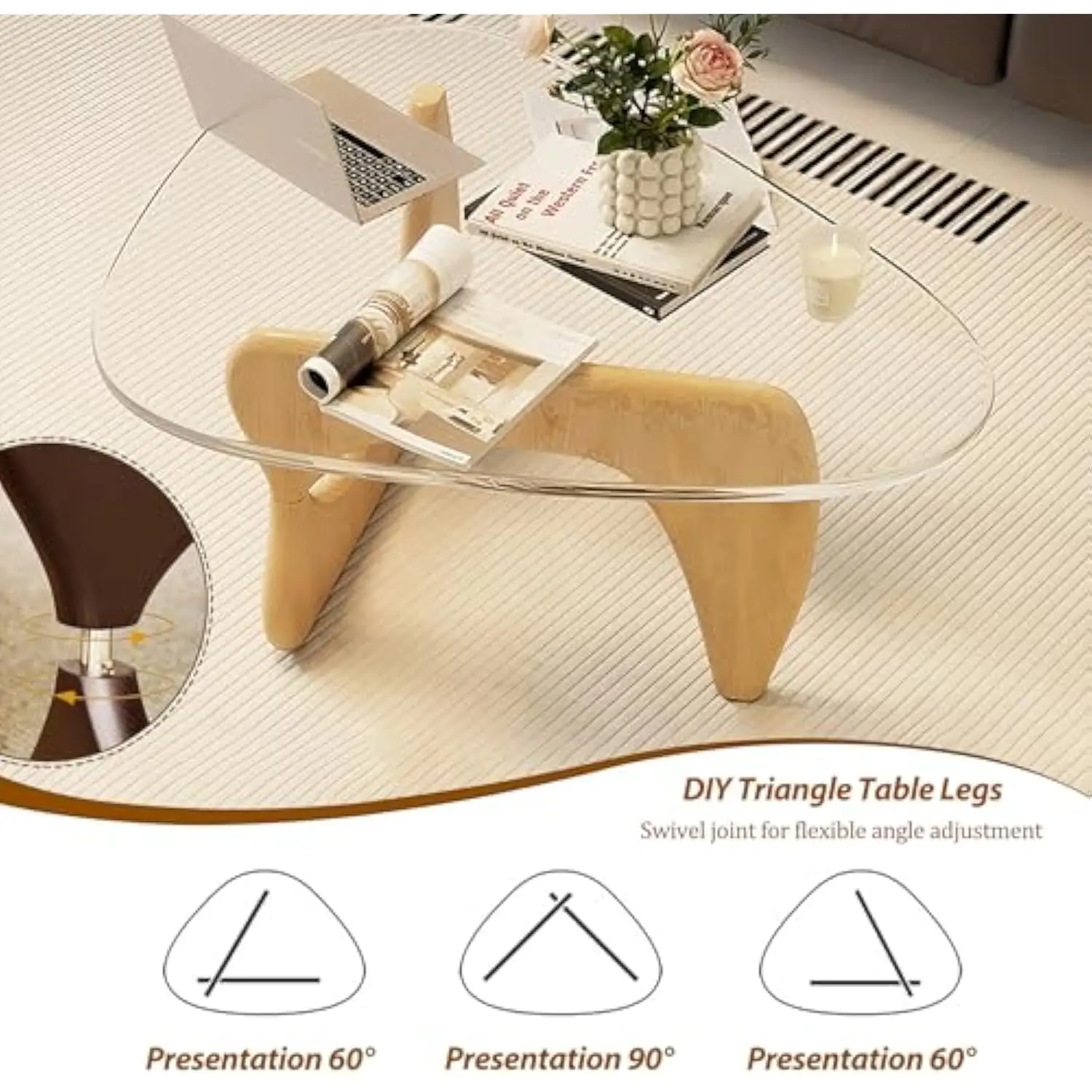
These statement pieces demand attention and often serve as the centerpiece around which the rest of a room’s design revolves. The best examples maintain functionality while pushing creative boundaries—offering practical surfaces while simultaneously providing visual excitement that energizes a space. Incorporating glass coffee table ideas open spaces allows these artistic pieces to be viewed from multiple angles, much like sculpture in a gallery setting.
When introducing a sculptural glass coffee table into your interior, consider allowing it adequate breathing room to be appreciated fully. These pieces typically work best when other elements in the room are more subdued, creating a visual hierarchy that allows the table to shine without competition. For collectors and design enthusiasts, these artistic tables represent an opportunity to bring museum-quality design into everyday living environments.
Exploring Glass Coffee Table Shapes and Their Impact on Design
The shape of a glass coffee table dramatically influences both its visual impact and its functionality within a space. Different forms create distinct effects on traffic flow, seating arrangements, and the overall feel of a room—making shape selection one of the most important considerations when choosing a glass coffee table.
Round Glass Coffee Tables
- Create natural flow in a room with their absence of sharp corners
- Work well in smaller spaces or rooms with many passage points
- Encourage conversation with their inclusive, gathering-friendly form
- Soften rooms dominated by rectangular furniture and architecture
- Pair beautifully with curved or sectional sofas
Rectangular Glass Coffee Tables
- Provide ample surface area for books, décor, and practical use
- Reflect the shape of most sofas for visual cohesion
- Create strong geometric lines that organize a space
- Allow for proportional scaling to match different sofa lengths
- Offer the most traditional and versatile coffee table configuration
Understanding the impact of various square round coffee table layout options helps create spaces that function efficiently while maintaining visual harmony. As a general guideline, allow at least 18 inches between a coffee table and surrounding seating for comfortable traffic flow, regardless of shape. For specific room configurations, consider how people will move around the table—rounded forms facilitate easier navigation in tight spaces, while rectangular tables maximize usable surface in larger rooms.
For contemporary living rooms, our mid-century modern rectangular coffee tables provide classic proportions with modern details. Their glass tops create visual lightness while their structured forms help organize surrounding furniture into cohesive conversation areas.
Base Materials That Elevate Glass Coffee Table Design
The base material of a glass coffee table fundamentally defines its character, creating the foundation for its aesthetic appeal and structural integrity. While the glass top provides function and visual lightness, the base establishes style, stability, and visual weight—making material selection crucial to the table’s overall design impact.
Metal Bases
- Steel: Offers industrial character with exceptional strength in thin profiles
- Brass/Gold: Provides warm luxury with sophisticated gleam and patina potential
- Chrome/Nickel: Creates sleek, reflective surfaces that complement contemporary spaces
- Bronze: Delivers classic elegance with rich, developing patinas over time
Wood Bases
- Walnut: Showcases rich, dark grains with mid-century modern appeal
- Oak: Provides lighter tones with distinctive grain patterns and traditional character
- Teak: Offers honey tones with excellent durability and natural water resistance
- Exotic woods: Create unique statement pieces with distinctive coloration and grain
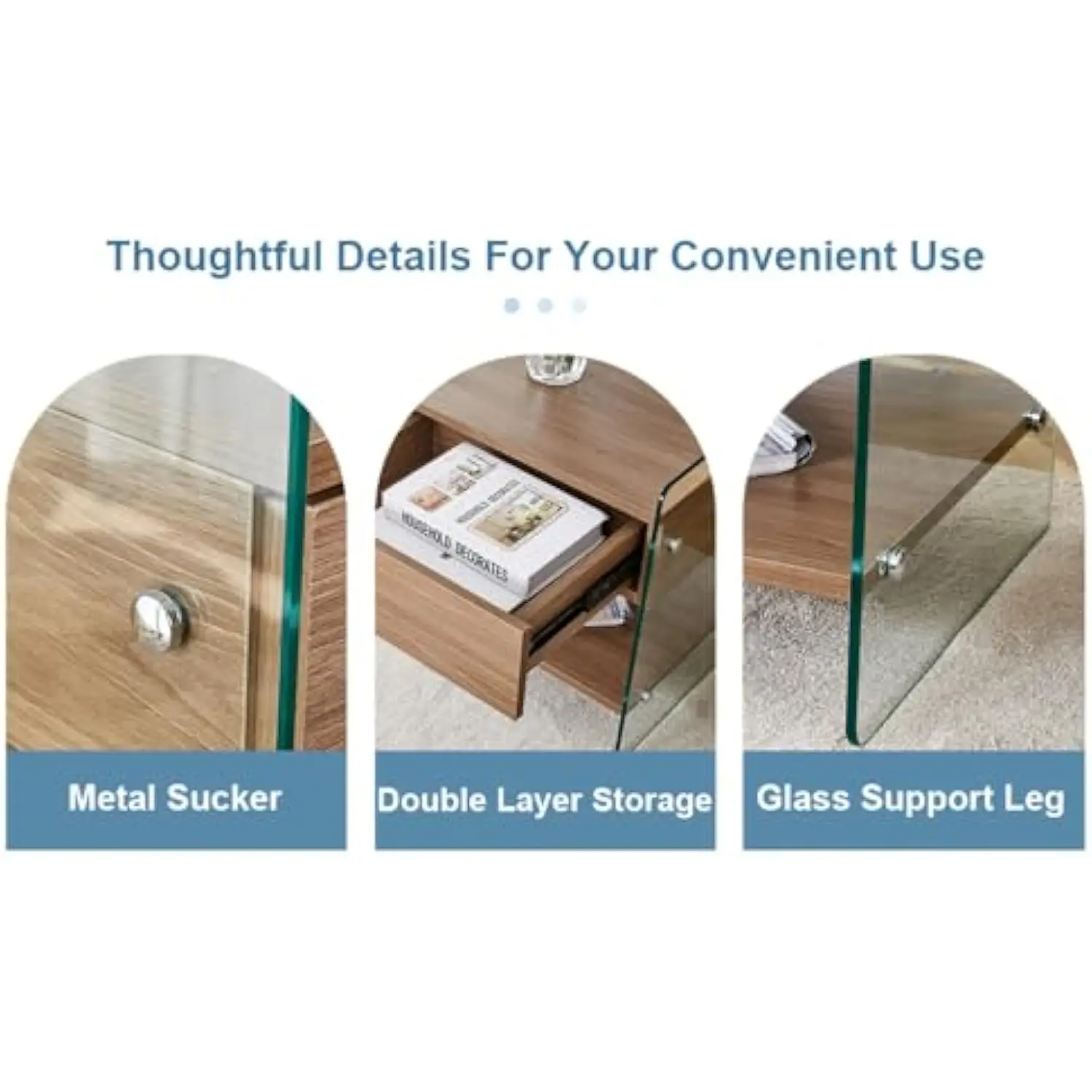
Mixed material designs often create the most intriguing visual statements, combining elements like brushed metal with warm wood, or stone components with glass shelving. These combinations create textural depth that single-material designs cannot achieve. When selecting base materials, consider both aesthetic preferences and practical concerns—some materials like natural stone require more maintenance, while powder-coated metals offer exceptional durability with minimal care.
For versatile options that maximize both style and function, our mid-century modern nesting coffee tables feature thoughtful material combinations that can be reconfigured as needed. These adaptable designs demonstrate how thoughtfully selected materials can enhance both the beauty and utility of glass coffee tables.
Functional Innovations in Contemporary Glass Coffee Tables
Modern glass coffee tables increasingly incorporate clever functional elements that enhance their usefulness without sacrificing style. These innovative features address common living space challenges while maintaining the aesthetic appeal that makes glass tables so desirable.
Leading functional innovations in glass coffee tables include:
- Lift-top mechanisms that raise portions of the surface for laptop use or casual dining
- Built-in storage drawers or shelves that maintain visual lightness while adding practicality
- Adjustable height systems that transform coffee tables into dining surfaces when needed
- Nesting designs that can be expanded for entertaining or condensed for daily use
- Integrated technology like charging stations or ambient lighting systems
These functional enhancements reflect evolving lifestyle needs, particularly in smaller living spaces where furniture must serve multiple purposes. The transparency of glass allows these mechanisms to be showcased rather than hidden, turning potential eyesores into design features. For example, the precision engineering of a lift mechanism becomes part of the visual appeal when paired with a glass top that reveals its workings.
When considering functionally enhanced glass coffee tables, evaluate which features genuinely address your specific lifestyle needs rather than choosing gimmicks that might rarely be used. The best functional designs maintain clean aesthetics while adding genuinely useful capabilities. For those looking to maximize their coffee table’s potential, mastering styling glass top coffee table arrangements with these functional pieces requires thoughtful organization that works with, rather than against, their special features.
Mid-Century Modern Glass Top Coffee Tables, Mid-Century Modern Glass Top Side & End Tables
$460.58 Select options This product has multiple variants. The options may be chosen on the product pageMid-Century Modern Glass Top Coffee Tables, Mid-Century Modern Vintage Coffee Tables, Mid-Century Modern Vintage Side & End Tables
$725.36 Select options This product has multiple variants. The options may be chosen on the product pageMid-Century Modern Large Coffee Tables, Mid-Century Modern Rectangular Coffee Tables
$603.26 Select options This product has multiple variants. The options may be chosen on the product pageMid-Century Modern Marble Top Coffee Tables, Mid-Century Modern Rectangular Coffee Tables, Mid-Century Modern White Coffee Tables
Price range: $163.28 through $189.22 Select options This product has multiple variants. The options may be chosen on the product pageMid-Century Modern Nesting Coffee Tables, Mid-Century Modern Nesting Table Sets
$361.45 Select options This product has multiple variants. The options may be chosen on the product pageMid-Century Modern Rectangular Coffee Tables, Mid-Century Modern White Coffee Tables
$605.68 Select options This product has multiple variants. The options may be chosen on the product page
Understanding Glass Types and Quality in Coffee Table Design
The quality and type of glass used in coffee tables significantly impacts both aesthetics and safety. Understanding these differences helps consumers make informed decisions about which glass coffee tables will best serve their needs while providing lasting durability.
Common Glass Types for Coffee Tables
Tempered Glass: Heat-treated to increase strength (typically 4-5 times stronger than standard glass). When broken, shatters into small, relatively harmless pieces rather than sharp shards. The industry standard for safety.
Laminated Glass: Created by bonding multiple glass layers with a plastic interlayer. If broken, the pieces adhere to the plastic rather than scattering. Offers excellent safety but is less commonly used in coffee tables.
Float Glass: Basic glass without safety treatment. Should be avoided for coffee tables due to dangerous breaking patterns.
Specialty Glass: Includes tinted, frosted, etched, or textured options that add visual interest while maintaining safety features.
Glass thickness also plays a crucial role in both durability and aesthetics. For coffee tables, 8mm to 12mm thickness provides an ideal balance of strength and visual elegance. Smaller tables may use 6mm glass, while larger designs often require 15mm or thicker glass to prevent flexing or warping.
Beyond thickness, quality indicators include perfectly polished edges, uniform clarity without distortion, and proper tempering certification. When purchasing a glass coffee table, always confirm it meets safety standards, particularly in households with children. The glass coffee table safety tips we recommend include checking for tempered glass certification and inspecting edges for proper finishing to prevent injuries.
How to Style Your Glass Coffee Table: Design Expert Tips
Styling a glass coffee table requires a different approach than decorating solid-surface tables due to its transparency. The visibility from all angles and through the surface itself creates both opportunities and challenges for creating visually appealing arrangements.
Expert tips for styling glass coffee tables include:
- Apply the Rule of Three: Group objects in odd numbers (typically three) for visual interest and balance
- Create Height Variation: Include items of different heights to create visual movement
- Layer with Books: Use coffee table books as foundational elements, creating platforms for smaller objects
- Incorporate Organic Elements: Add a small plant or fresh flowers to bring life and softness
- Consider Undertable Visibility: Remember that items can be seen through the glass—consider a beautiful rug underneath
- Maintain Negative Space: Allow some empty areas to prevent a cluttered appearance
- Balance Colors and Textures: Mix materials like metal, ceramics, and natural elements for visual richness
When arranging objects, think three-dimensionally—view your arrangement from all sides and from above to ensure it looks intentional from every angle. For rectangular tables, create defined zones using trays or books to organize smaller items. On round tables, consider a central focal point with supporting elements radiating outward.
Seasonal refreshes can be achieved by swapping out select accessories while maintaining core structural elements. This approach allows you to update your table’s look without completely redesigning your arrangement. Remember that the transparency of glass means less is often more—carefully selected items can have greater impact than numerous small accessories that create visual clutter.
Care and Maintenance for Long-Lasting Glass Coffee Tables
Proper care ensures your glass coffee table remains beautiful and functional for years to come. With relatively simple maintenance routines, you can prevent common issues like scratches, smudges, and potential damage to both glass and base materials.
Essential Glass Coffee Table Care Tips:
- Daily Dusting: Use a microfiber cloth to remove dust and fingerprints without scratching
- Weekly Cleaning: Apply glass cleaner to a cloth (not directly to the glass) and wipe in circular motions
- Spill Protection: Use coasters and placemats to prevent water rings and heat damage
- Scratch Prevention: Apply felt pads to any decorative items placed directly on glass
- Edge Inspection: Periodically check edges for chips that could worsen over time
- Base-Specific Care: Follow appropriate cleaning methods for wood, metal, or other base materials
- Weight Distribution: Avoid placing extremely heavy items on glass surfaces
Common Questions About Glass Coffee Table Care:
Q: Can I use regular household cleaners on my glass coffee table?
A: Avoid ammonia-based cleaners on tinted or treated glass. For tempered clear glass, standard glass cleaners are typically safe, but always check manufacturer recommendations.
Q: How do I remove stubborn smudges without scratching?
A: Make a paste with baking soda and water for stubborn spots, applying gently with a soft cloth in circular motions, then clean with a glass cleaner.
Q: Is it normal for glass tables to have slight imperfections?
A: Minor variations are normal in glass products. However, chips, cracks, or significant distortions are not acceptable quality standards and should be addressed.
For households with children, regular cleaning is particularly important to maintain visibility of any developing issues with the glass surface. With proper care, a quality glass coffee table can remain a beautiful focal point in your living space for many years.
How to Select the Perfect Glass Coffee Table for Your Space
Choosing the ideal glass coffee table requires thoughtful consideration of both practical needs and design preferences. By evaluating key factors systematically, you can find a piece that enhances your space both functionally and aesthetically.
Essential Selection Considerations:
Size & Proportion
* The table should be approximately two-thirds the length of your sofa
* Allow 12-18 inches between the table and seating for comfortable access
* Consider height in relation to seating—standard coffee tables are 16-18 inches high
* Ensure adequate clearance for movement around the table (at least 30 inches from table to walls or other furniture)
Room Compatibility
* Match table style to existing design elements for cohesion
* Consider shape based on room traffic patterns and available space
* Evaluate how glass will interact with lighting sources in the room
* Think about how the table will coordinate with flooring and rug choices
Lifestyle Factors
* Households with children may need rounded corners and thicker tempered glass
* Consider storage needs and whether additional surfaces are required
* Evaluate cleaning requirements based on your maintenance preferences
* Think about how you typically use your coffee table (decorative, functional, multipurpose)
Quality Indicators
* Look for tempered safety glass with proper certification
* Check for precise joinery and stable construction in the base
* Examine glass edges for proper finishing and smooth corners
* Verify weight capacity is appropriate for intended use
By taking time to evaluate these factors before purchasing, you’ll find a glass coffee table that not only looks beautiful in your space but also serves your practical needs for years to come. Remember that this central piece will influence both the function and feeling of your living area, making thoughtful selection particularly important.
Frequently Asked Questions About Glass Coffee Tables
Q: Are glass coffee tables safe in homes with children?
A: Glass coffee tables can be safe with proper precautions. Look for tables with tempered safety glass, rounded corners, and sturdy bases. Some manufacturers offer edge guards for additional protection. Supervise younger children around glass furniture and teach them not to climb or play roughly around these pieces.
Q: How do I prevent scratches on my glass coffee table?
A: Use felt pads under all decorative objects, avoid sliding items across the surface, and clean with microfiber cloths rather than paper towels or abrasive materials. Consider using decorative placemats or runners in high-use areas of the table.
Q: Can glass coffee tables support as much weight as wood tables?
A: Quality tempered glass coffee tables are designed to support significant weight—often 100+ pounds when properly designed. However, this varies by glass thickness, tempering quality, and base construction. Check manufacturer specifications for weight limits, and avoid standing or sitting on glass tables regardless of their rating.
Q: How do I incorporate a glass coffee table into a room with lots of other furniture?
A: Glass coffee tables work well in busy rooms because their transparency creates less visual weight. Choose a table with a base that coordinates with existing furniture finishes, and keep styling minimal to avoid adding to visual clutter. The transparent surface will help the room feel more spacious despite having numerous furniture pieces.

